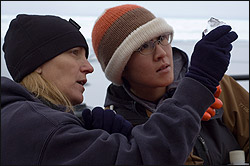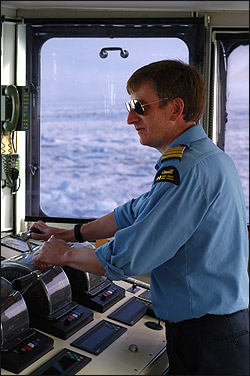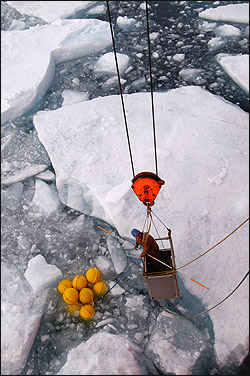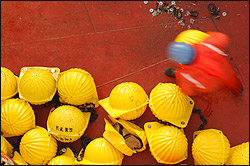Please note: You are viewing
the unstyled version of this website. Either your browser does not support CSS
(cascading style sheets) or it has been disabled. Skip
navigation.
Chris LinderAugust 25, 2005
As the clock ticked away through the morning hours, we completed the first science station since Gilligan's ice island--an XCTD cast and a bucket sample of surface water. We're counting every minute now, and with the thick ice slowing us even further, we can't stop just yet for a CTD. Hours later, just before dinner, we arrived at the Mooring C location. John Kemp and Kris Newhall performed a quick survey to make sure the mooring was still there and to confirm its location. Mooring C was a difficult one to deploy last year because of the heavy ice, and this year the conditions were as bad, if not worse. Recoveries are even more challenging because of the danger of having the mooring come up under ice. After dinner a large crowd gathered on the bridge, where the Captain was maneuvering the ship into position. He performed several test runs, clearing the ice in a "pond" to the starboard side of the bow and timing how long the pond lasted until the ice swept back in. We had about a minute. John estimated that after sending the release code to the mooring, it would appear in about fifteen seconds. Plenty of time. However, our Beaufort Triangle bad luck struck again. Jeffrey Carpenter and I were waiting on top of the bridge for our photo opportunity of the top float popping up right in the pond. We watched as the pond cleared, then Doug Sieberg lowered the transducer in the water. Fifteen, fourteen,.... two, one.. Nothing. Hmm, not unusual, perhaps one of the releases failed to open. John always uses two releases to be prepared for just this case. More scrambling on the deck below us, another pond created... and nothing. The minutes ticked away, and still no top float appeared. Eventually Sarah Zimmermann came up to fill Jeff and I in. "John says the mooring released, but it must have come up under the ice... you guys keep watch for the yellow floats from the bottom of the mooring-they should pop up in a half hour or so." More waiting, as we drove the ship in circles breaking up more of the ice. Then, half hidden under a jumble of multi-year ice, I saw a hint of yellow. Sure enough, there they were, a tangle of floats that was the bottom end of the mooring. After several failed attempts to hook the floats from the ship, John jumped into a small man basket and hooked the chain by hand. Finally, success--the mooring was coming up... bottom first. When winchman Peter King brought the floats on deck with the crane, we counted five shattered floats in the line. The glass showered out of the yellow casings as the balls were lowered to the deck. As if we didn't respect the power of the ice enough, here was another reminder--in the short time it took us to find the floats and bring them aboard, they had been crumpled by the shifting ice like they were made out of paper. As I finish the last sentences of this dispatch, I am watching 2000 meters of line spool on deck--it's 11:00PM and the mooring is still coming in. It's going to be a late night for the mooring team and deck crew; they haven't even found the moored profiling instrument or the top sphere yet. Stay tuned to tomorrow's dispatch from the Beaufort Gyre to see how we fared in our battle against the ice. Last updated: October 7, 2019 | ||||||||||||||||||||||
Copyright ©2007 Woods Hole Oceanographic Institution, All Rights Reserved, Privacy Policy. | ||||||||||||||||||||||






